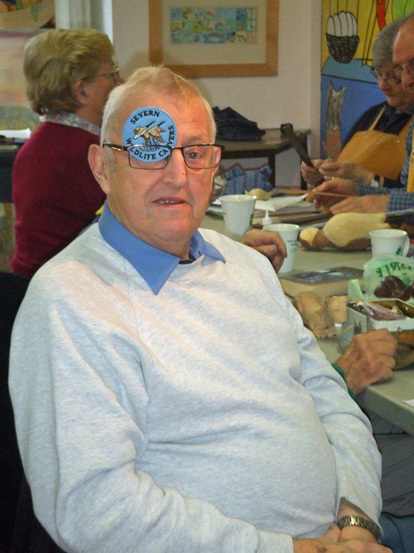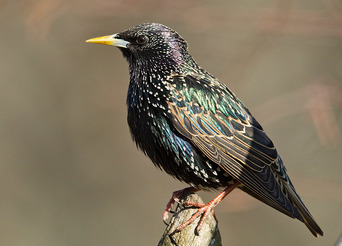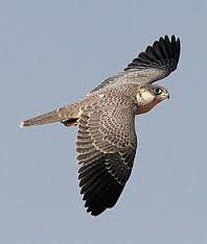SWC Annual Luncheon
The annual luncheon was once again held at the Tudor Arms at Slimbridge today (21st November). Being just down the road from WWT Slimbridge, our group meeting place it is ideally situated for us all to get to. The event was well supported and I am sure everyone had an enjoyable few hours.The food and service was excellent and staff helpful and attentive.
Finding a suitable venue is not easy and we have to thank Roger Francis who generously gives up valuable carving time to seek out venues and arrange everything for us. I have no doubt that we will back here next year.
Thanks Rog we all appreciate your efforts..
Finding a suitable venue is not easy and we have to thank Roger Francis who generously gives up valuable carving time to seek out venues and arrange everything for us. I have no doubt that we will back here next year.
Thanks Rog we all appreciate your efforts..
New Group Badge and Monthly Meeting
 Ah! Har! Captain Mike
Ah! Har! Captain Mike
The meeting on Saturday 15th November was very well attended. Whether this was because everyone wanted to get their hands on the new group badge or or because we had Ann and Colin from Woodworks Craft Supplies with us is debatable!
The new badge has been some time in making its appearance but seems to have been received very positively. One member in particular found a most novel use for it! (Left)
Our thanks go to Ann and Colin for taking the time to visit us, it was a great opportunity for us to top up our supplies and to have a hands on look at some nice pieces of equipment. The portable power carver caught the eye of one or two members but I don't think anyone splashed out on one (yet that is!) If you have purchased anything from Woodworks Craft Supplies you will know how helpful they can be and this occasion was no exception. Both Colin and Ann were happy to advise on equipment and its use. For example, I have used the fixed tip pens for several years. I also have a replaceable tip pen but never really got on with it. When discussing with Ann she immediately pointed out where I was going wrong with replace tip pen. As a result I ended up buying a few tips for several pounds instead of spending £30 or so on a new fixed tip pen!
We have our annual luncheon this Saturday (21st November) at the Tudor Arms Slimbridge.I am sure we will all have a very pleasant meal and enjoy each others company.
The new badge has been some time in making its appearance but seems to have been received very positively. One member in particular found a most novel use for it! (Left)
Our thanks go to Ann and Colin for taking the time to visit us, it was a great opportunity for us to top up our supplies and to have a hands on look at some nice pieces of equipment. The portable power carver caught the eye of one or two members but I don't think anyone splashed out on one (yet that is!) If you have purchased anything from Woodworks Craft Supplies you will know how helpful they can be and this occasion was no exception. Both Colin and Ann were happy to advise on equipment and its use. For example, I have used the fixed tip pens for several years. I also have a replaceable tip pen but never really got on with it. When discussing with Ann she immediately pointed out where I was going wrong with replace tip pen. As a result I ended up buying a few tips for several pounds instead of spending £30 or so on a new fixed tip pen!
We have our annual luncheon this Saturday (21st November) at the Tudor Arms Slimbridge.I am sure we will all have a very pleasant meal and enjoy each others company.
Stop Press!
If you are interested in finding out more about the White Fronted Geese in the article below click this link and enjoy http://tracking.wwt.org.uk/maps/telemetry.php
White Fronted Geese - Sue Harrison
Many thanks to Sue for sending in this this article on the Greenland White-Fronted Geese
I wondered if our members may be interested to read about the study we learnt about for the Greenland White-fronted geese whilst we had a five day stay on Islay. Some groups of these Greenland white-fronted geese had already arrived on Islay before us (180 birds). 7,500 are expected (25% of the world population) and they make their way to Islay via Iceland, from their breeding grounds in Greenland each winter, returning the following spring. These geese, are different from our Slimbridge, European white-fronted geese, which come from Russia. The Islay birds have a longer orange bill & darker plumage, compared with the pink bill of the Slimbridge birds. Apparently the Islay Greenland white-fronted geese are declining in numbers (at a faster rate than the global average) & the ornithologists can't work out why this is happening. So, for part of the study, the WWT are fitting collar-mounted telemetry devices with small solar panels on, because the data runs off mobile phone masts (as that is apparently more reliable than satellite), but when the geese are over the ice pack of Greenland, there are no masts, so need the solar panels to charge them up. Then the data is stored & downloaded at a later date. 5 tags have been able to send GPS data remotely through the mobile phone/GSM network. Great excitement is felt when the birds arrive back in northern Iceland, and therefore they are back within the mobile phone coverage, because they had last been last heard when the geese headed to Greenland last spring. This data has already showed one goose stayed on the pack ice of Greenland for 2 days (they think there must have been a white-out snow storm) then it flew back to Islay! Some geese have stayed on the Greenland ice pack for 7 or 8 days. I attach photos of a couple of Greenland white-fronts we saw on Islay on the RSPB reserve, some on a farmer's field, and a photo of the neck collar. It is possible to follow these tagged geese on the internet.
I wondered if our members may be interested to read about the study we learnt about for the Greenland White-fronted geese whilst we had a five day stay on Islay. Some groups of these Greenland white-fronted geese had already arrived on Islay before us (180 birds). 7,500 are expected (25% of the world population) and they make their way to Islay via Iceland, from their breeding grounds in Greenland each winter, returning the following spring. These geese, are different from our Slimbridge, European white-fronted geese, which come from Russia. The Islay birds have a longer orange bill & darker plumage, compared with the pink bill of the Slimbridge birds. Apparently the Islay Greenland white-fronted geese are declining in numbers (at a faster rate than the global average) & the ornithologists can't work out why this is happening. So, for part of the study, the WWT are fitting collar-mounted telemetry devices with small solar panels on, because the data runs off mobile phone masts (as that is apparently more reliable than satellite), but when the geese are over the ice pack of Greenland, there are no masts, so need the solar panels to charge them up. Then the data is stored & downloaded at a later date. 5 tags have been able to send GPS data remotely through the mobile phone/GSM network. Great excitement is felt when the birds arrive back in northern Iceland, and therefore they are back within the mobile phone coverage, because they had last been last heard when the geese headed to Greenland last spring. This data has already showed one goose stayed on the pack ice of Greenland for 2 days (they think there must have been a white-out snow storm) then it flew back to Islay! Some geese have stayed on the Greenland ice pack for 7 or 8 days. I attach photos of a couple of Greenland white-fronts we saw on Islay on the RSPB reserve, some on a farmer's field, and a photo of the neck collar. It is possible to follow these tagged geese on the internet.
2016 BDWCA Festival Of Birds - Regional Group Competition Species Announced

With the ink not yet dry on this year’s results sheet the Regional Group competition bird for 2016 has been announced! This year’s winners Northern Ireland, have chosen the (Common) Starling - Sturnus vulgaris. Criteria is very straightforward, carvings can be Male, Female, Juvenile and plumage any season and pretty much any finish you like, textured and painted or unpainted, Polished or smooth take your pick.
If you are a member of the BDWCA then you are eligible to enter a bird in this competition. This year we (SWC) had a very poor showing from our group so please if you are a member of the BDWCA support us and carve a bird for this completion. I will take any entries to Bakewell, all you have to do is make the effort to carve the bird ‘Simples’ as the Meerkat says! In this completion numbers count so we need as many entries as we can get to stand any chance of winning!
Happy carving – See you all at the October meeting
If you are a member of the BDWCA then you are eligible to enter a bird in this competition. This year we (SWC) had a very poor showing from our group so please if you are a member of the BDWCA support us and carve a bird for this completion. I will take any entries to Bakewell, all you have to do is make the effort to carve the bird ‘Simples’ as the Meerkat says! In this completion numbers count so we need as many entries as we can get to stand any chance of winning!
Happy carving – See you all at the October meeting
Australia's Rarest Falcon

Val and her husband Bill are currently on holiday in Australia. On their travels through the Norhern Territories they had the great good fortune to see the rarest Falcon in Australia, the Grey Falcon. Unfortunately they were unable to get a photograph so I have added a picture off the web for you of this beautiful bird. Thanks to Val and Bill for sharing their experience.
BDWCA Festival Of Birds 2015
The 2015 Festival of Birds was held at Bakewell as usual over the weekend of 12th & 13th September. From what I gather the The number of entries was about the same as last year. The weather on the Saturday started with some showers, one or two quite heavy but these cleared as the day progressed. The exhibition hall was reasonably busy on the Saturday. Sunday brought some lovely sunshine and the visitor numbers seemed to be much higher . The town was certainly very busy in comparison to Saturday.
As usual there were some wonderful carvings on display and I am happy to report that four members of the group notched up seventeen awards between them:
Ian Chappell - Advanced Class
Tony Sully - Intermediate Class:
Roger Francis - Intermediate Class:
I am sure most of you will remember Mark Montgomery a past active member of the group. Mark won 1st in the Advanced Game Birds with a beautiful flying Red Grouse.
Due to an SD card failure I have lost most of the pictures I took, so below is a very small selection which I were taken on my second card.
As usual there were some wonderful carvings on display and I am happy to report that four members of the group notched up seventeen awards between them:
Ian Chappell - Advanced Class
- 1st - Red Breasted Goose
- Highly Commended - Avocet
Tony Sully - Intermediate Class:
- Gold - Pintail Drake
- Silver - Mallard Drake
- Silver - Great Crested Greebe
Roger Francis - Intermediate Class:
- Silver - Brunnichs Guillemot
- Silver - Rufous Bush Robin
- Bronze - Pied Billed Greebe
- Bronze - Two Barred Crossbill
- Bronze - Fiery Throated Hummingbirds
- Bronze - Yellow Wagtail
- Bronze - Rufous Bush Robin
- Bronze - Lazuli Bunting
I am sure most of you will remember Mark Montgomery a past active member of the group. Mark won 1st in the Advanced Game Birds with a beautiful flying Red Grouse.
Due to an SD card failure I have lost most of the pictures I took, so below is a very small selection which I were taken on my second card.
Additional Bakewell Photographs courtesy Sue Harrison
Garden Ringing Report
 Lesser Redpoll
Lesser Redpoll
Many thanks to Sue Harrison for the photographs and information on the ringing activity in her garden.
We had a great morning last week, hoping to find out more information on the movements of some of our garden birds within the village, and also more about the actual birds in our garden. A couple who live in our village came over on Wednesday morning, 10 February, to spend a couple of hours putting rings on some of our garden birds. With the welfare of our birds paramount, a total of 42 different birds were very carefully caught and ringed, weighed and measured, sexed, and aged (as to whether it was a first year bird or an adult). 12 different species of birds were caught – 3 robins, which surprised us because at the most we have only seen 2 robins in our garden at the same time, and mostly it is one robin! We were thrilled to catch one of our garden Redpolls, which had been ringed in our village last year on 12 March 2014. None of us have seen Redpolls in our village in the summer months. Therefore this bird was in our village last winter, flew off somewhere else to breed, and has returned to exactly this same village again to spend this winter. A blue tit which was ringed in our village a year ago (19 January 2014) was also caught. This was hatched in 2013 and so will be coming up for 3 years old. If in doubt, “Identification Guide of European Passerines” by Lars Svensson was used to help age and sex the birds. Young birds could be recognised by their pointed tail feathers. Starlings were recognised as males because of their uniform dark eye, whereas the female starlings have a white or yellowish narrow circle around the iris. Goldfinch males were recognised by the more extensive red on their head.
We are keeping our fingers crossed that we may receive reports of these birds again to find out how long they live and where they go.
We had a great morning last week, hoping to find out more information on the movements of some of our garden birds within the village, and also more about the actual birds in our garden. A couple who live in our village came over on Wednesday morning, 10 February, to spend a couple of hours putting rings on some of our garden birds. With the welfare of our birds paramount, a total of 42 different birds were very carefully caught and ringed, weighed and measured, sexed, and aged (as to whether it was a first year bird or an adult). 12 different species of birds were caught – 3 robins, which surprised us because at the most we have only seen 2 robins in our garden at the same time, and mostly it is one robin! We were thrilled to catch one of our garden Redpolls, which had been ringed in our village last year on 12 March 2014. None of us have seen Redpolls in our village in the summer months. Therefore this bird was in our village last winter, flew off somewhere else to breed, and has returned to exactly this same village again to spend this winter. A blue tit which was ringed in our village a year ago (19 January 2014) was also caught. This was hatched in 2013 and so will be coming up for 3 years old. If in doubt, “Identification Guide of European Passerines” by Lars Svensson was used to help age and sex the birds. Young birds could be recognised by their pointed tail feathers. Starlings were recognised as males because of their uniform dark eye, whereas the female starlings have a white or yellowish narrow circle around the iris. Goldfinch males were recognised by the more extensive red on their head.
We are keeping our fingers crossed that we may receive reports of these birds again to find out how long they live and where they go.


















































